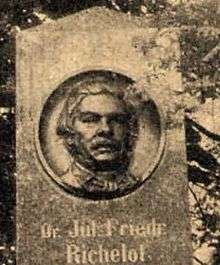Friedrich Julius Richelot
| Friedrich Julius Richelot | |
|---|---|
 Portrait on Richelot's tombstone | |
| Born |
6 November 1808 Königsberg, Prussia |
| Died |
31 March 1875 (aged 66) Königsberg, Prussia |
| Nationality | Prussian |
| Fields | Mathematics |
| Institutions | University of Königsberg |
| Alma mater | University of Königsberg |
| Doctoral advisor | Carl Gustav Jacob Jacobi |
| Doctoral students |
Joannes Meyer Carl Neumann Heinrich Schröter |
Friedrich Julius Richelot (6 November 1808 – 31 March 1875) was a German mathematician, born in Königsberg. He was a student of Carl Gustav Jacob Jacobi.
He was promoted in 1831 at the Philosophical Faculty of the University of Königsberg with a dissertation on the division of the circle into 257 equal parts (see references) and was a professor there.
Richelot authored numerous publications in German, French and Latin, among them — with his 1832 dissertation — the first known guide to the Euclidean construction of the regular 257-gon with compass and straightedge.
In 1825 he joined the Corps Masovia.[1]
He died in Königsberg in 1875.
References
- ↑ Kösener Korps-Listen 1910, 141, 8
Thesis
- Friedrich Julius Richelot: De resolutione algebraica aequationis x257 = 1, sive de divisione circuli per bisectionem anguli septies repetitam in partes 257 inter se aequales commentatio coronata. In: Journal für die reine und angewandte Mathematik. Nr. 9, 1832, S. 1–26, 146–161, 209–230, und 337–358.
|
This article is issued from Wikipedia - version of the Saturday, May 23, 2015. The text is available under the Creative Commons Attribution/Share Alike but additional terms may apply for the media files.